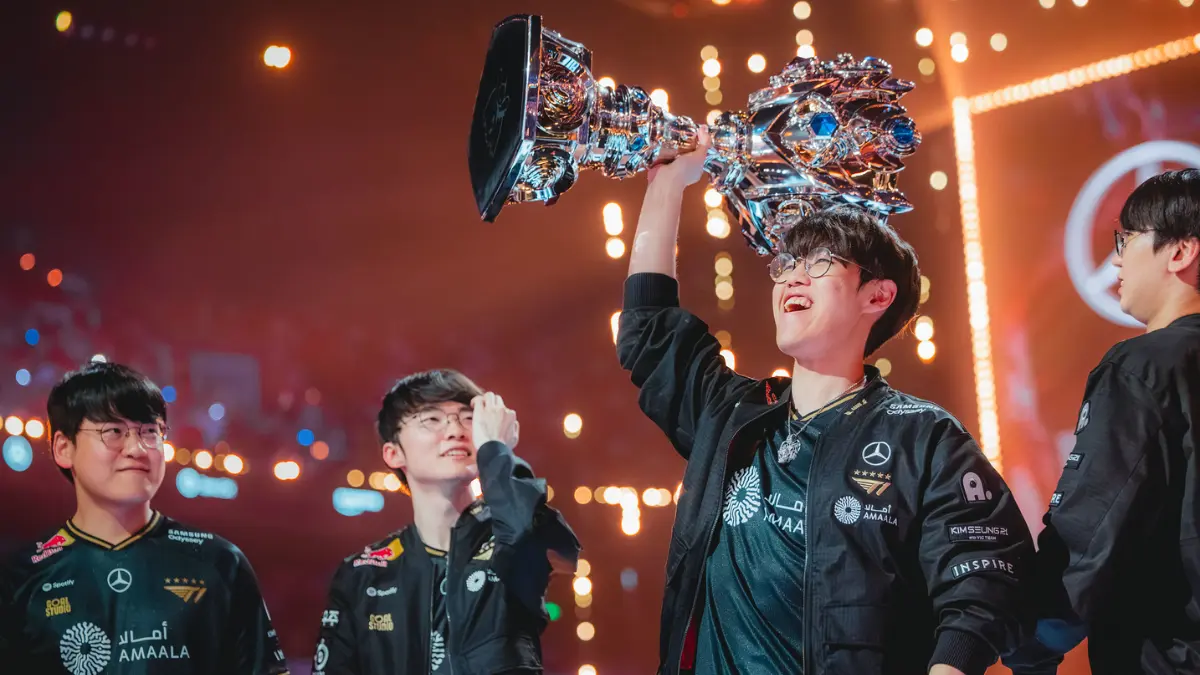When T1 lifted the Summoner’s Cup yet again in Chengdu on 9 November 2025, it felt less like the end of a tournament and more like a turning point in esports history. The 2025 League of Legends World Championship final brought together everything that makes modern esports so compelling: a decade-long rivalry, superstar legacies on the line, inventive game design, and a global audience that now rivals many traditional sports broadcasts.
This was not just another world final. It was the “Telecom War” on the biggest possible stage, with T1 and KT Rolster fighting through five tense games before T1 emerged victorious 3–2. The win completed T1’s unprecedented three-peat of World Championship titles, solidified the LCK’s dominance with a fourth straight Worlds victory, and gave Faker his sixth world crown in a career that no longer feels comparable to anyone else’s.
Below is a closer look at why Worlds 2025 stands out as one of the defining moments in esports so far.
Contents
A final built on a decade of rivalry
For long-time League of Legends followers, a T1 vs KT Rolster final is almost mythological. The “Telecom War” goes back to the early days of Korean LoL, when both organisations were backed by rival telecom giants and fielded rosters stacked with future Hall of Famers.
By 2025, the rivalry had evolved, but the emotional weight remained. KT had spent much of the season carving out a reputation as one of the most cohesive teams in the LCK, cruising through the early stages of Worlds with confident, methodical play. T1, meanwhile, arrived as the reigning back-to-back world champions, battle-hardened from years of deep international runs.
The format of Worlds 2025 added even more pressure. For the first time, the entire competitive calendar and split structure had been rebuilt, and the World Championship was positioned as the culmination of a denser, more global season. The new ecosystem meant less downtime, more cross-regional clashes, and a higher baseline level of preparation for every team that made it to China.
To reach the final, both Korean sides had to survive a stacked field of 17 teams from all over the world, all battling for a share of a $5 million prize pool. Upsets in the Swiss stage, surprise dark horses, and meta shifts kept the bracket unpredictable. In the end, though, Worlds reverted to its core storyline: Korea on top, and T1 vs KT once again playing for the biggest possible stakes.
The stage: Chengdu as a symbol of esports’ global reach
The series took place at the Dong’an Lake Sports Park Multifunctional Gymnasium in Chengdu, China, a modern arena that underlined just how far esports production has come.
China has a long history of hosting large-scale esports events, but Worlds 2025 felt like another level altogether:
- Production values rivalled top-tier traditional sports broadcasts, with elaborate opening ceremonies, AR effects, and constantly shifting stage lighting synced to champion abilities and game events.
- Crowd energy was intense and sustained, even during long pauses and analyst desk segments. The noise after each team-fight win was closer to a football stadium than an old-school LAN.
- Global representation was visible in the stands, with fans waving jerseys and flags from Korea, China, Europe, the Americas, and beyond, emphasising that Worlds has become a truly international spectacle.
T1’s three-peat and the evolving legend of Faker
T1’s victory made them the first team ever to win three consecutive World Championships. Considering how volatile League metas can be and how rapidly rosters change, that alone would make Worlds 2025 historic.
For Lee “Faker” Sang-hyeok, this title extends a legacy that was already unique. After re-signing with T1 until 2029 earlier in the year, Faker entered Worlds 2025 not as a star trying to prove he still had it, but as a franchise icon whose presence stabilised the whole line-up.
Several factors make this particular championship special:
- Sixth world title: No other player in League history is close to matching that number. At this point, Faker’s career is closer to a dynasty than a CV.
- New teammates thriving: While he remains the central figure, the 2025 roster also highlighted the rise of newer stars like Gumayusi and Doran. Gumayusi’s performance in the final earned him the MVP award, making him the first ADC to win Worlds Final MVP since Ruler in 2017.
- Adapting to Fearless Draft: The introduction of Fearless Draft in the broader ecosystem rewarded teams who could play an unusually wide champion pool. That T1 could still dominate in this environment underlined their flexibility and coaching depth.
The series itself: momentum swings and strategic layers
On paper, a 3–2 scoreline already tells you the final was close. In practice, the series was a masterclass in adaptation from both sides.
KT’s early statement
KT Rolster came into the final looking confident, leaning into strong team-fight compositions and clean objective control. Throughout the tournament, they had shown an ability to stabilise early and then choke opponents out around neutral objectives, and that same blueprint appeared in the opening games of the final.
Their drafts often gave Bdd and deokdam reliable, scaling picks, while Cuzz was trusted to control dragons and heralds. When KT were ahead, the map looked very small for their opponents: deep vision lines, precise rotations, and little room for flanks or surprise picks.
T1’s resilience and Gumayusi’s MVP performance
But if there is one thing T1 have built their brand on, it’s resilience. After early setbacks, they adjusted champion priorities, gave Gumayusi more agency in lane, and let Faker roam more aggressively to support side-lanes.
Key to their comeback were:
- Targeted adaptations in draft: T1’s coaching staff recognised which of KT’s comfort picks were doing the most damage and pivoted bans and flex picks to destabilise them.
- Bot-lane dominance: Gumayusi and Keria found windows to create pressure even from even or slightly behind states, turning skirmishes around dragons and barons into opportunities to re-take control of the map.
- Team-fight execution: In late-game situations with multiple stopwatches, summoner spells and zone-control ultimates, T1 repeatedly showed better coordination, layering CC and damage with clinical timing.
Where betting fits into modern esports
As events like Worlds grow, so does the ecosystem around them, and that includes esports betting. A significant portion of the audience now follows tournaments not only as fans of specific teams or players, but also as participants in prediction markets, fantasy formats and regulated wagering.
For those who do choose to bet, platforms such as 1 Win have built out dedicated esports sections that mirror the depth of traditional sports markets. On a 1Win betting site, you can find lines on match winners, map handicaps, total kills, and even niche props tied to specific in-game objectives or player performances.
It is worth stressing, though, that betting should always remain an optional, adult-only layer on top of the competition, not its main purpose. The healthiest approach is to treat wagers as a form of paid entertainment with strict limits, rather than a way to “guarantee” profit-especially in a game as unpredictable as League of Legends, where a single misplayed fight can flip an entire series.
The business angle: sponsorship, media rights and fan engagement
From a commercial perspective, Worlds 2025 also highlighted how far esports monetisation has come—and how much room still remains to grow.
Sponsorship and brand integration
Brands from tech, energy drinks, banking, telecoms and fashion all found ways to integrate into the broadcast and the live event. Some were visible on team jerseys; others sponsored segments on the analyst desk or in-arena experiences.
The sophistication of these partnerships has evolved significantly:
- Activations now tend to be more interactive: fan competitions, AR filters, watch-party collaborations and social-media challenges.
- Long-term partnerships with teams and leagues signal that sponsors see esports as a stable part of their marketing mix, rather than a one-off experiment.
Media rights and streaming
On the media side, Worlds 2025 continued the trend of multi-platform distribution:
- Official broadcasts ran on Riot’s own platforms and mainstream streaming services.
- Co-streaming rights allowed popular content creators to add their own commentary, toning the broadcast to their communities and drawing in casual viewers who might not normally watch a full best-of-five.
- Regional language streams—from Korean and Chinese to Spanish, Portuguese and more—ensured that fans could follow the action in their preferred language.
Betting on the go: mobile, emerging regions and responsible play
As esports spreads across time zones, mobile access is becoming as important as desktop for fans who want to keep up with match schedules, stats and odds.
In markets where mobile-first internet usage is the norm, like much of South Asia, platforms such as 1Win India have leaned into lightweight, smartphone-optimised interfaces and simplified registration flows to bring esports betting to a wider adult audience. Meanwhile, the dedicated 1Win app allows fans to follow live odds while they watch matches on another device, building multi-screen rituals similar to what football or cricket fans already do.
Again, the key caveat is that any form of gambling carries risks. Setting deposit limits, avoiding chasing losses, and never staking money needed for essentials are all non-negotiable practices. Reputable operators provide tools for self-exclusion, timeouts, and reality checks, and those tools only matter if they’re actually used. Worlds may deliver peak adrenaline, but betting decisions are always better when they’re made calmly, not in the heat of a pentakill.
What Worlds 2025 tells us about the future of esports
Taken as a whole, the 2025 League of Legends World Championship final felt like a proof-of-concept for where top-tier esports is heading:
- Stability at the top, volatility below: Giants like T1 can sustain dominance over many years, but the path beneath them is constantly shifting as new organisations rise, fall, and retool.
- City-scale events as the norm: Worlds in Chengdu reinforced the idea that major esports tournaments aren’t just arena events; they’re city-wide festivals that can drive tourism and local spending.
- A maturing ecosystem around the game: From sponsors and streaming platforms to fantasy and regulated betting, the broader economy around League of Legends continues to diversify.
- Player legacies reaching new heights: With a sixth world title, Faker’s career is starting to resemble that of the greatest athletes in traditional sports—names associated with entire eras rather than individual trophies.
- Growing need for governance and player welfare: As schedules get denser and stakes increase, conversations around burnout, fair contracts and regional sustainability will only become more important.
Are online casinos and sports betting sites a scam or a legitimate business?
Online casinos and sports betting sites are not inherently scams; they are legitimate businesses operating within regulated frameworks in many countries. Their business model revolves around providing a platform where users can place bets or gamble on games of chance or skill, such as poker, blackjack, or sports events.
These platforms make money by offering games with a built-in “house edge,” meaning the odds are slightly in favor of the casino, ensuring long-term profitability. For example, the house edge for games like blackjack typically ranges from 0.5% to 2%, while for slot machines, it can range from 2% to 10% or more. For sports betting, they set odds that allow them to profit regardless of the outcome, typically by taking a commission or “vig” on bets, which usually falls between 5% and 10% depending on the platform.
Legitimacy depends on the regulation and licensing of the platform. Licensed operators must adhere to strict rules, including transparent odds, fair gameplay, and secure handling of customer funds. Unregulated or illegal sites pose risks like rigged games and potential theft of funds.
While many online casinos and betting sites are legitimate businesses providing entertainment to users, it is vital to do thorough research before engaging. Checking for proper licensing and user reviews helps ensure you are using reputable platforms rather than falling victim to scams in an unregulated market.




